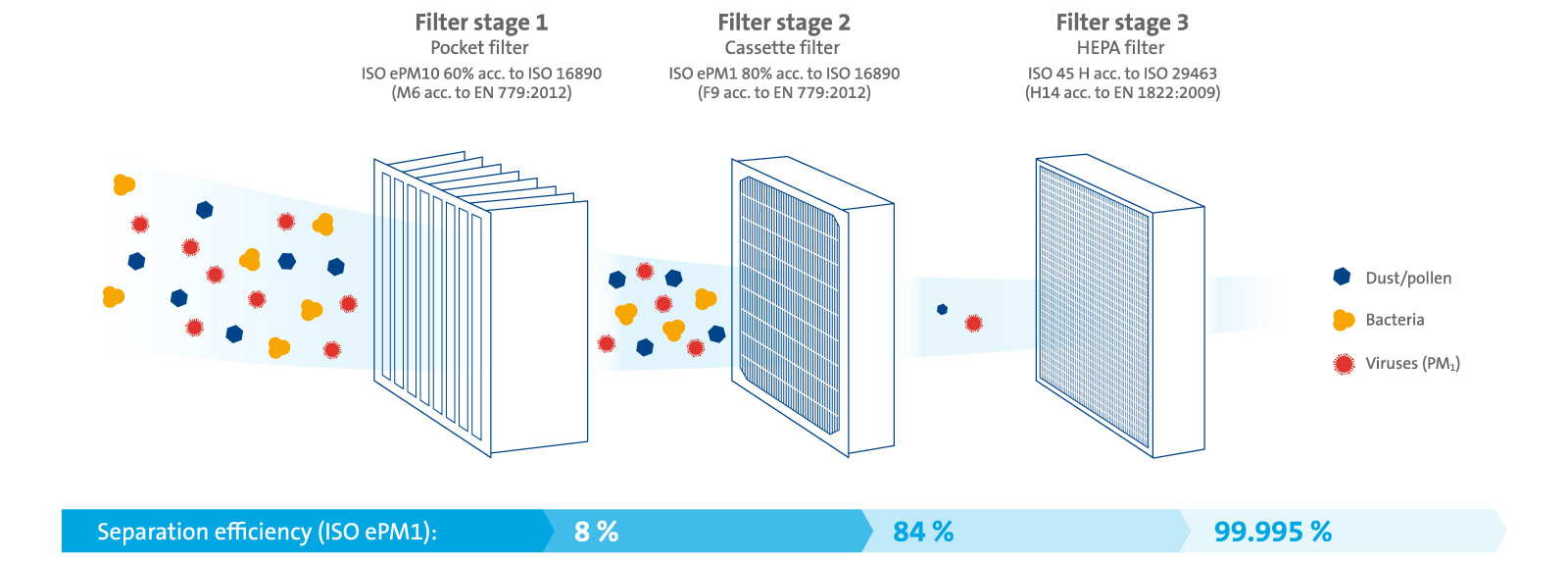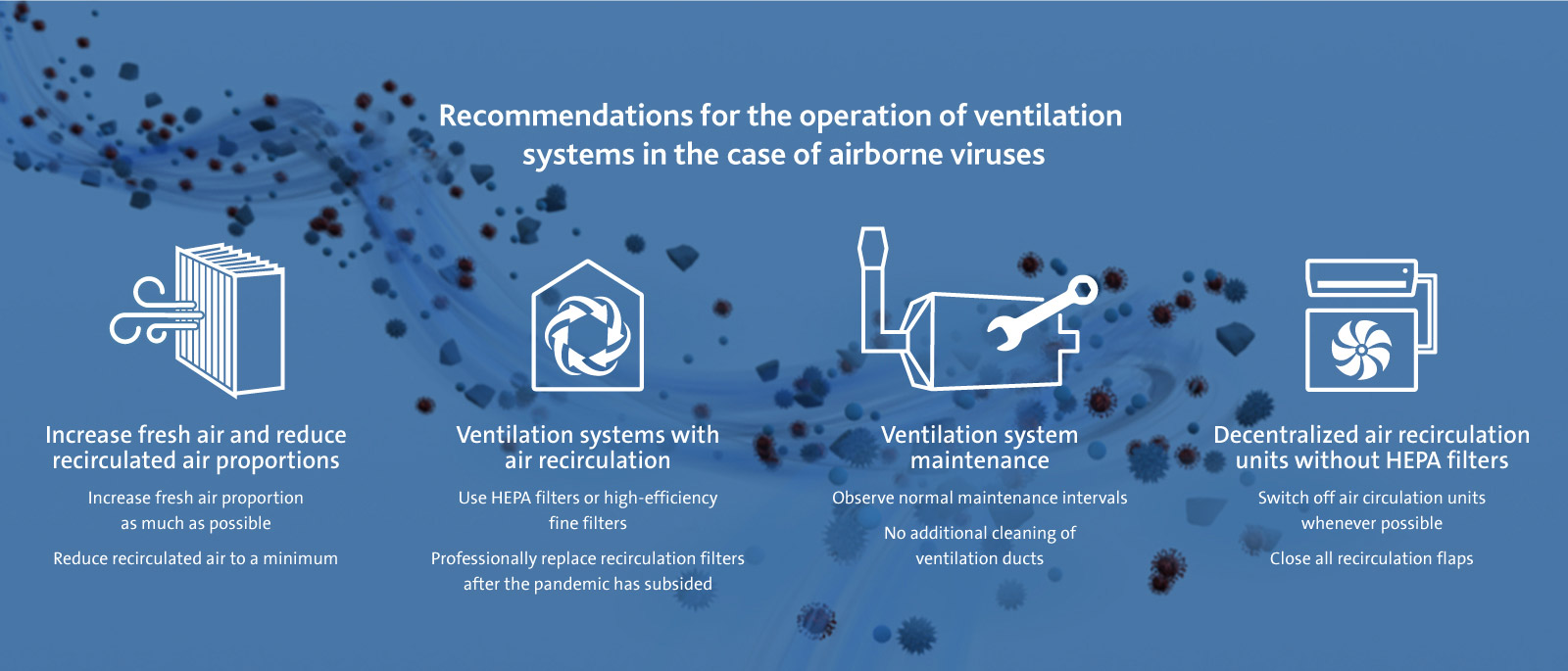Fewer viruses thanks to
multi-stage air filter systems
Effectively reduce the risk of infection indoors
A common infection pathway is droplet infection. The virions are distributed in the air by droplets of <5 µm. Powerful filter elements and multi-stage air filtration systems can almost completely separate these particle sizes and thus effectively reduce the pathogen concentration in the room air:
Filter stages and separation efficiencies
Air filters of different filter classes are combined in a multi-stage system to ensure the desired indoor air quality. The basis for perfectly matched filter stages and the classification of air filters is the ISO 16890 test standard. Air filters are classified into the corresponding ISO classes based on their separation efficiency of the different particle sizes PM10, PM2.5 and PM1. For HEPA filters (EPA, HEPA and ULPA filter classes), the new ISO 29463 provides orientation based on the European filter standard EN 1822.
Filter stage 1Pocket filters initially separate most of the larger particles (PM10) such as dust and pollen from the supply and recirculated air. Their low pressure drops make them particularly energy efficient.
Filter stage 2Almost all PM2,5 particles are filtered in filter stage 2. Cassette filters excel here with their high dust holding capacity and stable separation efficiency.
Filter stage 3The third stage with HEPA filters is responsible for ensuring sterility and clean room air. A HEPA/ULPA filter of filter class H14 removes more than 99.995 % of the remaining particles, germs and viruses from the air – and thus effectively minimizes the risk of contracting infections indoors.
Here is an exemplary representation:

Individually tailored concepts
Every room has its own specific requirements. The most effective air filter system is therefore always a solution that has been individually tailored to meet the local conditions and individual needs.
Minimize the risk of contamination through individual services and solutions
- Comprehensive, individual planning and conception of your air filtration system
- Commissioning and implementation by our expert technicians
- Maximum hygiene protection through compliance with VDI Guideline 6022
- Regular inspection and maintenance with Viledon FilterCair
- Professional replacement of contaminated filter elements
Our technical filter information contains further details on how to protect against germs and viruses.
Recommendations for the operation of ventilation systems in the case of airborne viruses
How to effectively reduce the risk of infection indoors
In the current situation, operators of ventilation systems are facing particular challenges with regard to the correct handling of viruses. They want to provide the best possible protection for people indoors against infection and prevent the ventilation systems themselves from becoming a source of contamination.
Suitable air filter systems can help to effectively reduce the risk of infection indoors. Perfectly matched filter stages efficiently separate particles from the air and thus protect against the spread of airborne viruses via the ventilation system. In addition, the proportion of fresh air should be increased as much as possible to further reduce the pathogen concentration in the room air. The proportion of recirculated air should be reduced to a minimum.
For ventilation systems with air recirculation, HEPA filters or high-efficiency fine filters should be used, if this is technically possible and the differential pressure generated is not too high for the ventilation system. After the pandemic has subsided, it is recommended that the recirculation filters be replaced professionally.
When servicing and maintaining ventilation systems (fresh air operation), the normal maintenance intervals can be observed. Additional cleaning of the ventilation ducts or premature replacement of air filters is not necessary. When changing the filters, however, it is recommended to pack the removed filters airtight and dispose of them in a waste incineration plant.
Decentralized air recirculation units such as small air conditioners usually filter the air with simple particle filters and lead it back into the room. Therefore, recirculation units should be switched off whenever possible and all recirculation flaps should be closed. This can prevent the unit itself from becoming a source of contamination and spreading viruses in the room.
The REHVA has published further recommendations in an information paper "REHVA Covid-19 guidance document”:
https://www.rehva.eu/fileadmin/user_upload/REHVA_covid_guidance_document_2020-03-17_final2.pdf

Your compact air filter FAQ
-
How do air filters work to protect against viruses?
A common infection pathway is droplet infection. The virions are distributed in the air by tiny droplets of <5 µm. Powerful filter elements can separate these particle sizes almost completely from the air and thus reduce the pathogen concentration in the room air.
The recirculation component of the ventilation system plays a major role in the germ load of rooms. High levels of fresh air reduce the virus concentration in contaminated rooms because the contaminated air does not circulate within the building. The risk of becoming contaminated by germs in the circulating air is negligible.
-
What happens to viruses in air filters?
Powerful HEPA filters separate the tiniest particles such as viruses to a particularly high degree. Because they cannot reproduce themselves, once separated the viruses remain in the filter and decompose over time. Microbiologically inactive filters such as our HEPA filter H14 (according to EN 1822) capture more than 99.995 % of all particles and aerosols to which viruses can adhere.
Since viruses need liquid water to survive, they decompose relatively quickly in the filter elements, as long as these are not saturated. This is true even at higher levels of relative humidity.
-
Can a filter itself become a source of contamination?
To prevent air filters from becoming a source of germs themselves and dispersing them around buildings, proper operation and maintenance are crucial. Systems that meet the requirements of VDI Guideline 6022 are designed to offer comprehensive protection from a hygienic point of view – from planning and operation to maintenance.
Together with the professional replacement of filter elements, expert servicing of the entire ventilation and air-conditioning system (including the thermodynamic treatment steps of heating, cooling, humidifying and dehumidifying) minimizes the risk of filters becoming a source of contamination.
-
How are contaminated filters replaced?
Filter elements that have come into contact with highly infectious viruses, such as the novel corona virus, must be replaced by experts following a specific procedure. The act of changing the filters has the effect of contaminating the rooms. This means that they must be sterilized or decontaminated before being used again. This can be done by spraying with hydrogen peroxide, via heat or radiation sterilization, or through ethylene oxide sterilization.
Because of this, many filter systems that are used in particularly sensitive areas such as isolation stations have special protocols to ensure contamination-free filter changes.
-
Do the maintenance intervals have to be increased due to viruses in the air?
If a ventilation system is properly operated and maintained according to schedule, no additional filter changes are necessary. Air filters are not usually a source of contamination when maintained properly. However, we do recommend air filters for ventilation systems with circulating air operation, change the filters at the latest after the pandemic has subsided.
It is also not necessary to increase the cleaning cycles of ventilation ducts, as a ventilation system is not a source of contamination if the recommendations of VDI 6022 for air conditioning systems are observed. Viruses that adhere to small droplets or particles can of the air flow is difficult to deposit in the ventilation ducts. They are normally carried on by the airflow. It is much more important to increase the fresh air proportion and minimize, if possible eliminate the recirculated air proportion.
Where can I find more information about handling viruses?
Operators of ventilation systems are often faced with special challenges regarding the correct handling of viruses. For this reason, many institutes and organizations are dealing with this critical topic, especially due to the current situation. For further information we have therefore compiled a list of links to interesting and informative websites, which we constantly update and expand for you:
ASHRAEAmerican Society of Heating, Refrigerating and Air-Conditioning Engineers
Current information on the use of Covid-19:
https://www.ashrae.org/technical-resources/resources
Document on airborne infectious diseases:
https://www.ashrae.org/file%20library/about/position%20documents/airborne-infectious-diseases.pdf
(as of 05 February 2020)
EUROVENTEurope's Industry Association for Indoor Climate (HVAC), Process Cooling, and Food Cold Chain Technologies
https://eurovent.eu/
REHVAFederation of European Heating, Ventilation and Air Conditioning Associations
Current information on the use of Covid-19:
https://www.rehva.eu/activities/covid-19-guidance
Guidelines for handling Covid-19:
https://www.rehva.eu/fileadmin/user_upload/REHVA_covid_guidance_document_2020-03-17_final2.pdf
(as of 17 March 2020)
Robert Koch Institute (RKI)Central institution of the German Federal Government in the field of disease surveillance and prevention
Current information on Covid-19:
https://www.rki.de/DE/Content/InfAZ/N/Neuartiges_Coronavirus/nCoV.html
VDMA Mechanical Engineering Industry Association
Europe's largest industrial association
Information document “Ventilation and air conditioning systems in times of Covid-19 – Principles of operation and use”:
https://alt.vdma.org/en/viewer/-/v2article/render/48582833
Current information on Covid-19:
https://www.vdma.org/en/corona
World Health Organization (WHO)
United Nations Coordinating Authority for International Public Health
Current information on Covid-19:
https://www.who.int/emergencies/diseases/novel-coronavirus-2019
Discover our filtration solutions and services for sensitive sectors
With the right filter selection you effectively reduce the risk of infection
Discover our products for HVAC systems
Click on “Details” for more information. Technical data and specific product features can be found in the e-catalog.
Show products in e-catalog
Robust in sustained use, high operational dependability and reliability even in the face of extreme moisture and wet conditions. They enable the energy-efficient operation of air conditioning systems. This translates to energy cost savings and a reduction in CO2 emissions.
The premium class in patented quality. Highly stable filter designs for the greatest possible operational dependability even under extreme loads. Water-repellent. Long service life, making them very economical.
Satisfy the highest requirements for clean air and sterility of filter classes E11 to U15. Reliable protection against particles and microorganisms. The MiniPleat technology ensures a homogeneous media velocity for safe, economical operation.
 Language / Country
Language / Country





